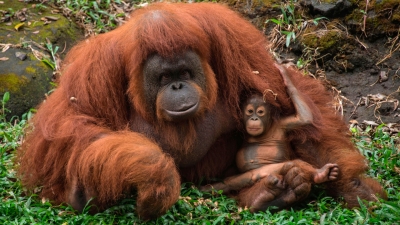
Orangutans share at least 28 physical traits with humans; that’s 26 more than chimps and 21 more than gorillas. Inside our mouths, we’ve both got flat molars that are covered with a thick layer of enamel. And, according to researcher Schwartz, “A hole in the roof of the mouth that was supposedly unique to humans is also present in organs.”
Orangutans, as well as other great apes, age similarly to humans, found researchers publishing in Veterinary Pathology. Humans live longer than all other great apes, but other than that, we all suffer from tooth, bone, and muscle mass loss; sensory impairment; cardiovascular disease; hair loss and graying; frailty; and arthritis, a condition that can take on 100 different forms in humans.
Other tell-tale features that link orangutans to humans, to the exclusion of chimps, bonobos, and gorillas? According to National Geographic, they have “greater asymmetries between the left and right side of the brain, an increased cartilage-to-bone ratio in the forearm, and similarly shaped shoulder blades.”
“Probably only humans have a more intensive relationship with their mothers,” according to Orangutan Foundation International. “Primatologists believe that orangutans have such long ‘childhoods’ because there is so much that they need to learn before they can live alone successfully.” Juvenile orangutans hang with mom till they’re about 8 years old, and nurse for pretty much the whole time.
Credit : Reader’s Digest
Picture Credit : Google




